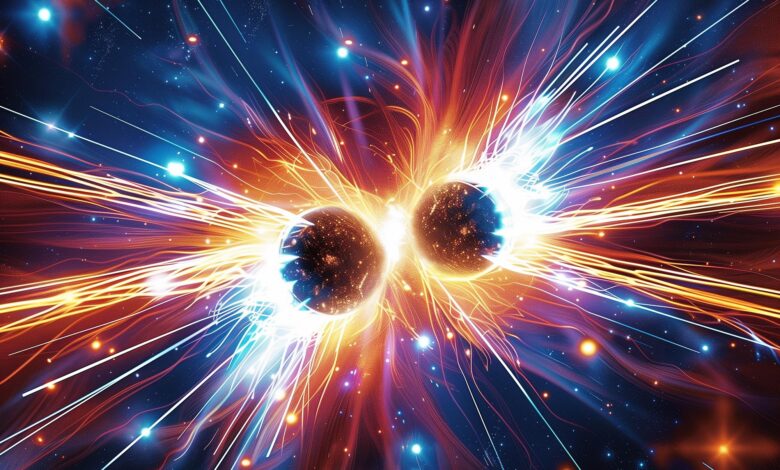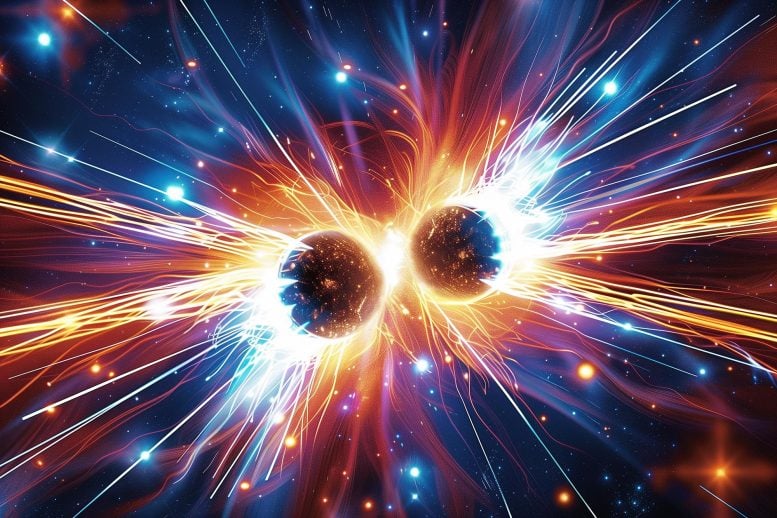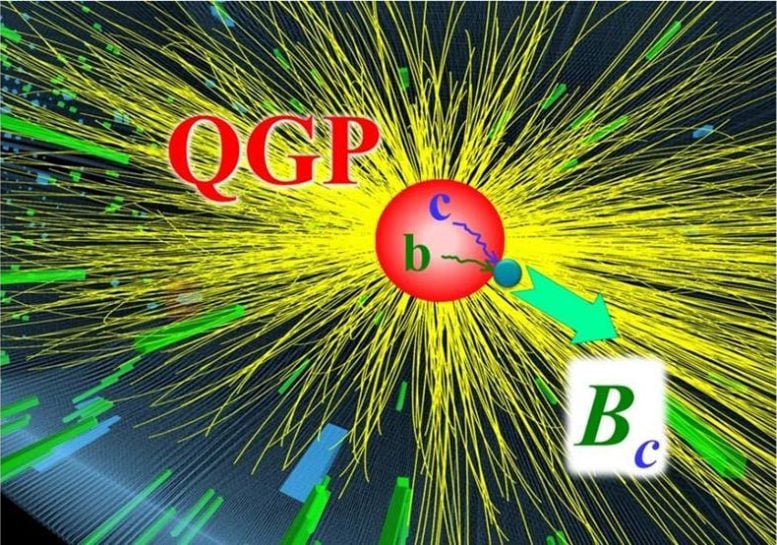From Lead to Light, How Colliders Illuminate Big Bang Physics

By

High-energy collisions help recreate and study quark-gluon plasma, focusing on the recombination of charm and bottom quarks into Bc mesons, a key signature of QGP. Experimental data from the Large Hadron Collider corroborates the theoretical predictions, with further studies aimed at refining detection of these mesons. Credit: SciTechDaily.com
Researchers use high-energy heavy-ion collisions to investigate quark-gluon plasma (QGP), studying its transient existence and the unique production of Bc mesons through charm and bottom quark recombination.
These findings, supported by preliminary data from the Large Hadron Collider, highlight the potential of Bc mesons as indicators of QGP, with expected advancements in detection methods to provide more conclusive evidence.
High-energy collisions of atomic nuclei provide a unique opportunity to recreate the quark-gluon plasma (QGP) in the laboratory, for a brief moment. The QGP is a fundamental, extremely hot form of nuclear matter in which protons and neutrons dissolve into quarks and gluons. It filled the early universe in the first few microseconds after the Big Bang. Scientists use collisions of heavy ions (particles with an electrical charge) to produce large numbers of the heavy charm and bottom quarks. These quarks are excellent probes of QGP formation. Specifically, the recombination of freely moving charm and bottom quarks facilitates the production of Bc mesons—particles made of an equal number of quarks and antiquarks—when the QGP decays.

Quark recombination in the quark-gluon plasma formed in high-energy nuclei collisions enhances the production of Bc mesons. These mesons consist of a charm quark and a bottom quark. Most of the quark-gluon plasma decays into thousands of other particles. Credit: CERN (CMS Collaboration, B. Wu, Z. Tang, M. He, and R. Rapp)
Tracking the Quark-Gluon Plasma
A QGP formed in high-energy heavy-ion collisions only lasts for a short time before disintegrating into thousands of particles that can be observed in detectors. These detectors track signatures—the signals produced by specific types of particles. The discovery and study of QGP formation in heavy-ion experiments requires signatures that do not occur in other types of collisions, such as proton-proton collisions. In this study, researchers carried out theoretical simulations of charm and bottom quarks diffusing through the QGP. They found that the recombination of these quarks enhances the production of Bc mesons. This mechanism does not occur in proton-proton collisions and thus can serve as a clean signature of QGP formation.
Enhancing Bc Meson Production in QGP
Researchers from the HEFTY Topical Collaboration investigated the recombination of charm and bottom quarks into Bc mesons in the QGP. They have developed a transport model that simulates the kinetics of heavy-quark bound states through the expanding QGP fireball formed in high-energy heavy-ion collisions. Previous research has successfully used this model to describe the production of charm-anticharm and bottom-antibottom bound states, and thus can provide predictions for Bc particles (charm-antibottom bound states).
The researchers used realistic spectra of charm and bottom quarks, computed from their diffusion through the QGP, to evaluate their recombination processes. The results show a large enhancement of the Bc yield in collisions of lead (Pb) nuclei, relative to that in proton collisions. The largest effect is predicted for slow-moving Bc mesons in “head-on” collisions of the Pb nuclei, where a large QGP fireball with appreciable numbers of charm and bottom quarks is formed.
Future Prospects and LHC Data
The theoretical calculations agree with pioneering data of the CMS collaboration at the Large Hadron Collider (LHC). However, the data are not yet sensitive to slow-moving Bc mesons; future data will therefore provide a critical test of this QGP signature.
Reference: “Recombination of 𝐵𝑐 mesons in ultrarelativistic heavy-ion collisions” by Biaogang Wu, Zhanduo Tang, Min He and Ralf Rapp, 18 January 2024, Physical Review C.
DOI: 10.1103/PhysRevC.109.014906
This work was supported by the Department of Energy Office of Science, Office of Nuclear Physics through the Topical Collaboration in Nuclear Theory on Heavy-Flavor Theory (HEFTY) for QCD Matter. This research was also funded by the National Science Foundation and the National Natural Science Foundation of China.



